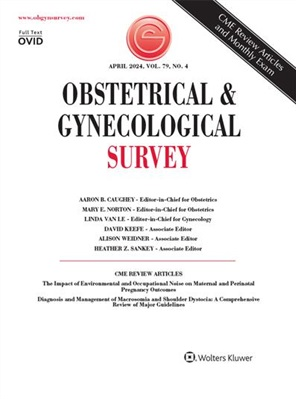Utilisation of Hospital-Based Specialist Palliative Care in Patients With Gynaecological Cancer: Temporal Trends, Predictors and Association With High-Intensity End-of-Life Care
IF 4.3
4区 医学
Q1 OBSTETRICS & GYNECOLOGY
引用次数: 0
Abstract
ABSTRACT Although chemotherapy and short-course radiotherapy play important roles in the palliative management of gynecological cancers, these may be associated with significant discomfort and minimal symptom control in advanced disease. Terminally ill patients approaching death may have complex palliative care needs that cannot be resolved in general care practices and require multidisciplinary specialist palliative care services (SPC). Timely access to SPCs is associated with improved quality of life and reduced high-intensity care during the end-of-life phase; however, the role of palliative care on high-intensity interventions at the end of life in patients with gynecological cancers has not been examined in large-scale studies. This nationwide registry-based study aimed to examine the temporal trends, predictors of use, and relationship with high-intensity treatments in hospital-based SPC utilization among patients with gynecological malignancies. All adults in Denmark who died of gynecological cancer between 2010 and 2016 were included. Demographic, financial, and oncological data were obtained for each patient. Utilization of SPC included care provided during hospital admissions, in outpatient clinics, or in the patients' own home. High-intensity end of life care included invasive treatments (chemotherapy, surgery, and radiation), use of services such as emergency department visits, intensive care unit admissions, or more than 1 hospital admission within 30 days, as well as no hospice admissions in the prior year or a patient death in the hospital. Binary regression was used to estimate the chance of receiving hospital-based SPC and the adjusted relative risk of high-intensity end of life care by potential predictors including cancer type, age at death, comorbidity score, region of residence, marital status, income level, migrant status, and FIGO cancer stage. A total of 4502 patients with cervical cancer (n = 708), ovarian cancer (n = 2595), and endometrial cancer (n = 1199) were identified, of whom 179 (40.0%) accessed SPC. The proportion of patients dying of gynecological cancer and receiving SPC increased from 24.2% in 2010 to 50.7% in 2016. Each potential predictor studied was associated with receiving SPC at the end of life, with the strongest associations after adjustment for year of death between 2014 and 2016, younger age, 3 or more comorbidities, residence in Danish regions other than the Capital region, and being an immigrant or descendant. Patients aged 60 to 69 had a 24% decreased chance of receiving SPC compared with those aged 18 to 59 (adjusted relative risk [aRR], 0.76; 95% confidence interval [CI], 0.69–0.83), and as age increased, the proportion of those that received SPC decreased further. Those with 3 or more comorbidities had a 23% higher chance of receiving SPC (aRR 1.23; 95% CI, 1.13–1.34). Compared with nonimmigrants, immigrants and descendants were 29% more likely to receive SPC (aRR, 1.29; 95% CI, 1.14–1.96). Hospital-based SPC, particularly when accessed >30 days before death, was associated with lower utilization of all high-intensity end of life care including a 25% lower risk of dying during a hospital admission (aRR, 0.75; 95% CI, 0.68–0.84). The results of this study demonstrate that the proportion of patients dying of gynecological cancers and receiving hospital-based SPC increased significantly between 2010 and 2016, and these patients received fewer high-intensity end of life interventions and were less likely to die during a hospital admission.利用医院为基础的专科姑息治疗妇科癌症患者:时间趋势,预测因素和关联与高强度临终关怀
尽管化疗和短程放疗在妇科癌症的姑息治疗中发挥着重要作用,但在晚期疾病中,化疗和短程放疗可能会带来明显的不适和很少的症状控制。接近死亡的绝症患者可能有复杂的姑息治疗需求,无法在一般护理实践中解决,需要多学科专科姑息治疗服务(SPC)。及时获得特别保健服务与生活质量的提高和生命末期高强度护理的减少有关;然而,姑息治疗在妇科癌症患者生命末期高强度干预中的作用尚未在大规模研究中得到检验。这项基于全国登记的研究旨在检查妇科恶性肿瘤患者中基于医院的SPC使用的时间趋势、预测因素以及与高强度治疗的关系。2010年至2016年期间丹麦所有死于妇科癌症的成年人都被纳入研究范围。获得每位患者的人口统计、财务和肿瘤数据。SPC的使用包括住院期间、门诊诊所或患者自己家中提供的护理。高强度临终关怀包括侵入性治疗(化疗、手术和放疗)、使用急诊科就诊等服务、入住重症监护病房或30天内住院1次以上,以及前一年未入住临终关怀院或患者在医院死亡。采用二元回归方法,通过癌症类型、死亡年龄、合并症评分、居住地区、婚姻状况、收入水平、移民身份和FIGO癌症分期等潜在预测因子,估计接受基于医院的SPC的机会和高强度临终关怀的调整相对风险。共发现4502例宫颈癌(708例)、卵巢癌(2595例)和子宫内膜癌(1199例),其中179例(40.0%)使用了SPC。妇科肿瘤死亡患者接受SPC的比例从2010年的24.2%上升到2016年的50.7%。研究的每个潜在预测因素都与生命结束时接受SPC相关,在调整2014年至2016年死亡年份、年龄更小、3个或更多合并症、居住在丹麦首都地区以外的地区、移民或后裔后,相关性最强。与18 - 59岁的患者相比,60 - 69岁的患者接受SPC的机会降低了24%(调整后的相对风险[aRR], 0.76;95%可信区间[CI], 0.69-0.83),随着年龄的增长,接受SPC的比例进一步下降。有3个或更多合并症的患者接受SPC的机会高出23% (aRR 1.23;95% ci, 1.13-1.34)。与非移民相比,移民及其后代接受SPC的可能性高出29% (aRR, 1.29;95% ci, 1.14-1.96)。以医院为基础的SPC,特别是在死亡前30天获得的SPC,与所有高强度临终关怀的利用率较低相关,包括住院期间死亡风险降低25% (aRR, 0.75;95% ci, 0.68-0.84)。本研究结果表明,2010年至2016年期间,妇科癌症患者死亡和接受医院SPC的比例显著增加,这些患者接受的高强度临终干预较少,住院期间死亡的可能性较小。
本文章由计算机程序翻译,如有差异,请以英文原文为准。
求助全文
约1分钟内获得全文
求助全文
来源期刊
CiteScore
2.70
自引率
3.20%
发文量
245
审稿时长
>12 weeks
期刊介绍:
Each monthly issue of Obstetrical & Gynecological Survey presents summaries of the most timely and clinically relevant research being published worldwide. These concise, easy-to-read summaries provide expert insight into how to apply the latest research to patient care. The accompanying editorial commentary puts the studies into perspective and supplies authoritative guidance. The result is a valuable, time-saving resource for busy clinicians.

 求助内容:
求助内容: 应助结果提醒方式:
应助结果提醒方式:


